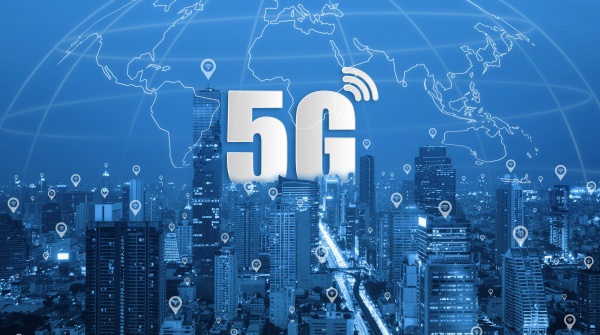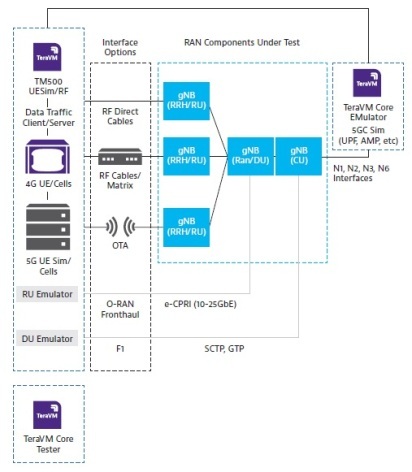Accelerate the rollout of 5G infrastructure test solutions

Operators and equipment suppliers are adopting Open Radio
Access Network (RAN) technologies, including O-RAN Alliance standards, to
minimize infrastructure development costs and reduce barriers to new product
innovation.

The global deployment of the fifth-generation mobile
network (5G) continues to advance, and new services are gradually available to
enhance user experience and implement challenging applications.
It is important to realize that the 5G network is not
only an improvement in the performance of 4G technology (in terms of upload and
download speed), or a simple upgrade to existing standards and protocols. In
addition to typical mobile phone applications, 5G technology will be able to
support higher-level services and applications, such as autonomous vehicles,
vehicle-to-vehicle and vehicle-to-everything communication (V2V and V2X),
virtual reality (VR) and augmented reality (AR), HD video streaming and IoT
applications. The new features provided by 5G networks can be summarized as
follows:
eMBB (Enhanced Mobile Broadband): 5G's higher bandwidth will
allow smooth and efficient use of applications such as augmented reality, video
streaming, and video conferencing;
mMTC (Massive Machine Type Communication): 5G will be able
to manage large-scale connections (thousands of simultaneously connected
devices and millions of connections) without overloading the network. This will
allow effective management of complex IoT applications, such as smart homes,
smart cities, smart grids, etc.;
URLLC (Ultra Reliable Low Latency Communication): This
service will provide support for all applications that require real-time
behavior and extremely low latency, such as factory automation, industrial
control systems, autonomous vehicles, smart grids, and surgical robots.
The role of testing
Because of the rapid technological progress and 5G will
place high requirements on network infrastructure, a comprehensive test plan
from the laboratory to the field, from RAN to the core is required. In
addition, operators and equipment suppliers are adopting Open Radio Access
Network (RAN) technologies, including O-RAN Alliance standards, to minimize
infrastructure development costs and reduce barriers to new product innovation.
As shown in Figure 1, the 5G network test mainly includes
three stages:
Validation: The technology was validated in the laboratory
before deployment.
Verification: Verify the network and its services on site
through appropriate field tests.
Visibility: This stage aims at ensuring, optimizing the
network and achieving profitability.

Figure 1: The three key stages of 5G testing (Figure
provided by VIAVI Solutions)
5G test solution
The deployment of 5G networks and solutions requires a test
and measurement company to help vendors and operators test their 5G
telecommunications equipment. This involves not only wireless communication
testing, but also optical fiber measurement, field measurement using a spectrum
analyzer, and so on.
"In terms of telecommunications testing, we will test
3G, 4G and 5G networks, including open radio access networks," said Owen
O'Donnell, VIAVI Solutions wireless solutions manager, in an interview with EE
Times Europe. "Operators and equipment manufacturers around the world are
adopting Open RAN to minimize infrastructure deployment costs and reduce barriers
to new product innovation."
VIAVI Solutions stated that it has developed a comprehensive
test suite that includes modules for laboratory verification, field deployment
and service assurance.
One thing that needs to be clarified is the difference between
laboratory and field testing. Labs are places where vendors who develop new
base stations or 5G core networks want to test what has been developed to
ensure that they are actually working in accordance with requirements or
applicable standards. Telecommunications standards, such as those set by 3GPP,
are developing very rapidly, and vendors need to develop their products to meet
the new standards.
O'Donnell said: "Suppliers need to verify that they
have actually correctly understood and implemented the standards. This is where
VIAVI Solutions comes in. Therefore, we will help them go to the laboratory,
and we will help them by simulating those elements. No."
For example, if a supplier wants to test a base station,
VIAVI can provide solutions that simulate the behavior of thousands of UEs
(such as mobile phones), send relevant messages to the base station and test
whether it processes these UE messages correctly. At the other end of the base
station, a core network can be simulated, so that the base station forwards the
call setup request to the core network and gets the correct return from it.
Therefore, the base station under test can use two VIAVI products, a UE
simulator and a core network simulator. From a standard compliance point of
view, this will help base station manufacturers to ensure that their base
stations work properly.
O'Donnell said: "This test can be done in the
laboratory. In the laboratory, things may fail without affecting anyone in the
live network." "But when you enter the actual live network on site At
that time, you also need to perform other tests, such as beamforming
tests."
5G should provide users with better throughput, more
connections, and more IoT devices.
"Operators have specific KPIs they want to achieve, but
we don't know what these numbers are until we enter the site and measure the
actual throughput and the number of connections to the terminal base
station," O'Donnell said.
In 5G, the core network is completely different from the 4G
core network. The core network has been completely re-developed and redesigned,
and new elements have been added. Importantly, those independent elements of
the core network can now be provided by different vendors.
"We need to make sure that all these elements work
together, and then they work together with actual traffic," O'Donnell
said.
This is exactly where TeraVM, one of the tools based on the
VIAVI lab, comes in. TeraVM is an application simulation and security
performance solution that provides comprehensive test coverage for application
services, wired and wireless networks. Figure 2 shows how TeraVM and other
VIAVI tools can be used to verify the 5G SBA (Service Based Architecture)
virtual mobile core and its components.

Figure 2: Using TeraVM for 5G testing (Figure provided by
VIAVI Solutions)
When people cannot easily access the laboratory (especially
during a pandemic, such as the recent Covid-19), then they will move the test
to the cloud. Therefore, they can access the system from home or from any
location with IP connectivity. To meet this need, VIAVI puts its system test
solution in the cloud. Users log in to Amazon Web Services, can select and
reserve some instances, upload the test plan to these instances, and test on
the cloud platform. Therefore, the test solution will only be used when
necessary, that is, the time required to test the function.